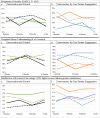A randomized intervention involving family to improve communication in breast cancer care
- PMID: 33579966
- PMCID: PMC7881185
- DOI: 10.1038/s41523-021-00217-9
A randomized intervention involving family to improve communication in breast cancer care
Abstract
We examined the effects of a communication intervention to engage family care partners on patient portal (MyChart) use, illness understanding, satisfaction with cancer care, and symptoms of anxiety in a single-blind randomized trial of patients in treatment for breast cancer. Patient-family dyads were recruited and randomly assigned a self-administered checklist to clarify the care partner role, establish a shared visit agenda, and facilitate MyChart access (n = 63) or usual care (n = 55). Interviews administered at baseline, 3, 9 (primary endpoint), and 12 months assessed anxiety (GAD-2), mean FAMCARE satisfaction, and complete illness understanding (4 of 4 items correct). Time-stamped electronic interactions measured MyChart use. By 9 months, more intervention than control care partners registered for MyChart (77.8 % vs 1.8%; p < 0.001) and logged into the patient's account (61.2% vs 0% of those registered; p < 0.001), but few sent messages to clinicians (6.1% vs 0%; p = 0.247). More intervention than control patients viewed clinical notes (60.3% vs 32.7%; p = 0.003). No pre-post group differences in patient or care partner symptoms of anxiety, satisfaction, or complete illness understanding were found. Intervention patients whose care partners logged into MyChart were more likely to have complete illness understanding at 9 months (changed 70.0% to 80.0% vs 69.7% to 54.6%; p = 0.03); symptoms of anxiety were numerically lower (16.7% to 6.7% vs 15.2% to 15.2%; p = 0.24) and satisfaction numerically higher (15.8-16.2 vs 18.0-17.4; p = 0.25). A brief, scalable communication intervention led to greater care partner MyChart use and increased illness understanding among patients with more engaged care partners (NCT03283553).
Conflict of interest statement
The authors declare no competing interests.
Figures


References
Associated data
Grants and funding
- P30 CA006973/CA/NCI NIH HHS/United States
- SAC170001/Susan G. Komen (Susan G. Komen Breast Cancer Foundation)
- R21 AG049967/AG/NIA NIH HHS/United States
- P30CA006973/U.S. Department of Health & Human Services | NIH | National Cancer Institute (NCI)
- 5R21AG049967/U.S. Department of Health & Human Services | NIH | National Institute on Aging (U.S. National Institute on Aging)
LinkOut - more resources
Full Text Sources
Other Literature Sources
Medical

